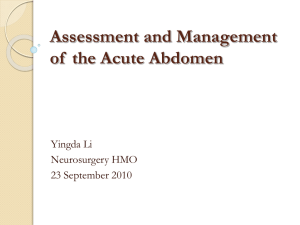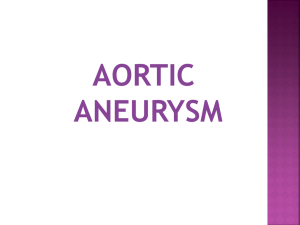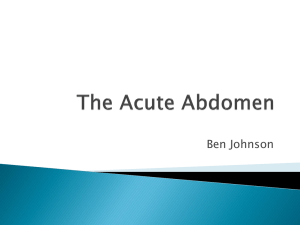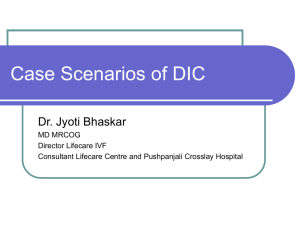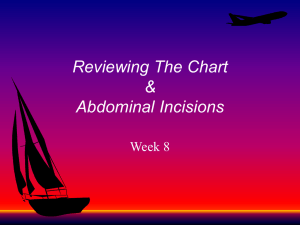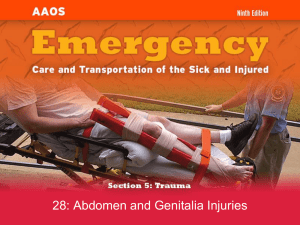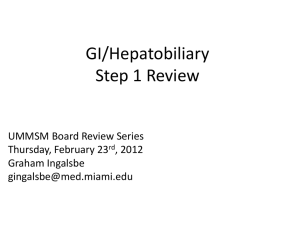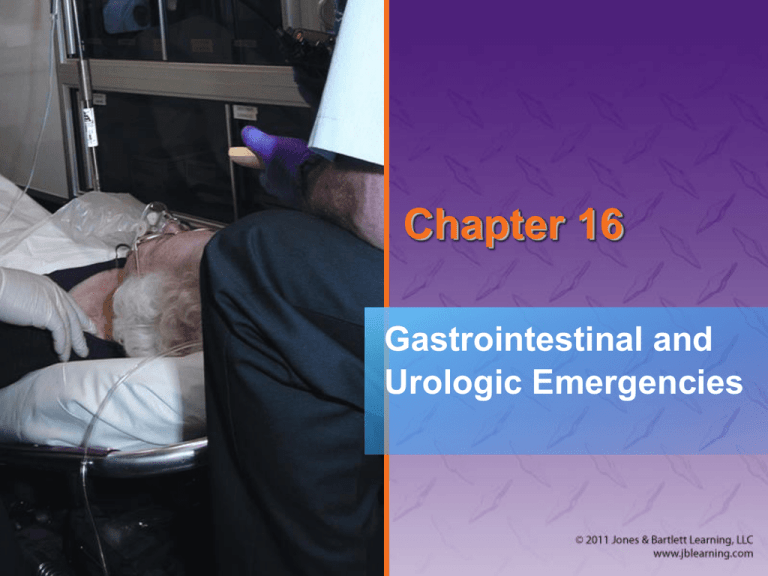
Chapter 16
Gastrointestinal and
Urologic Emergencies
National EMS Education
Standard Competencies (1 of 4)
Medicine
Applies fundamental knowledge to provide
basic emergency care and transportation
based on assessment findings for an acutely
ill patient.
National EMS Education
Standard Competencies (2 of 4)
• Abdominal and Gastrointestinal
Disorders
– Anatomy, presentations, and management of
shock associated with abdominal emergencies
• Gastrointestinal bleeding
National EMS Education
Standard Competencies (3 of 4)
• Abdominal and Gastrointestinal
Disorders (cont’d)
– Anatomy, physiology, pathophysiology,
assessment, and management of:
• Acute and chronic gastrointestinal
hemorrhage
• Peritonitis
• Ulcerative diseases
National EMS Education
Standard Competencies (4 of 4)
• Genitourinary/Renal
– Blood pressure assessment in hemodialysis
patients
– Anatomy, physiology, pathophysiology,
assessment, and management of:
• Complications related to:
– Renal dialysis
– Urinary catheter management (not insertion)
• Kidney stones
Introduction (1 of 2)
• Abdominal pain is a common complaint.
– Cause of abdominal pain is often difficult to
determine.
• As an EMT:
– You do not need to determine exact cause.
– You should be able to recognize a lifethreatening problem and act.
Introduction (2 of 2)
Anatomy and Physiology (1 of 4)
• Abdominal cavity contains:
– Gastrointestinal system
– Genital system
– Urinary system
• Made up of solid and hollow organs
Anatomy and Physiology (2 of 4)
• Solid organs include:
– Liver
– Spleen
– Pancreas
– Kidneys
– Ovaries
• Injury to a solid organ can cause shock and
bleeding.
Anatomy and Physiology (3 of 4)
• Hollow organs include:
– Gallbladder
– Stomach
– Small intestine
– Large intestine
– Urinary bladder
• Breach into hollow organs causes contents
to leak and contaminate abdominal cavity.
Anatomy and Physiology (4 of 4)
Hollow organs
Solid organs
The Gastrointestinal System
(1 of 6)
• Responsible for digestion process
• Digestion begins when food is chewed.
– Saliva breaks down food.
– Food is swallowed.
– Food travels to stomach.
• Stomach is main digestive organ.
The Gastrointestinal System
(2 of 6)
• Liver assists in digestion.
– Secretes bile
• Aids in digestion of fats
– Filters toxic substances
– Creates glucose stores
• Gallbladder is a reservoir for bile.
The Gastrointestinal System
(3 of 6)
• Small Intestine
– Duodenum
• Digestive juices from pancreas and liver mix.
– Pancreas secretes enzymes breaking down
starches, fats, protein.
– Pancreas produces bicarbonate, insulin.
– Jejunum
• Absorbs digestive products
• Does most of the work
The Gastrointestinal System
(4 of 6)
• Small intestine (cont’d)
– Ileum
• Soluble molecules are absorbed into blood.
• Proteins, fats, starches reduce to amino
acids, fatty acids, simple sugars.
The Gastrointestinal System
(5 of 6)
• Colon (large intestine)
– Food that isn’t used comes here.
– A movement called peristalsis moves waste
through intestines.
– Water is absorbed.
– Stool is formed.
The Gastrointestinal System
(6 of 6)
• Spleen
– Located in abdomen
– No digestive function
– Part of lymphatic system
•
•
•
•
Assists in filtering blood
Develops red blood cells
Blood reservoir
Produces antibodies
The Genital System (1 of 2)
• Male reproductive system:
– Testicles
– Epididymis
– Vasa deferentia
– Seminal vesicles
– Prostate gland
– Penis
The Genital System (2 of 2)
• Female reproductive system:
– Ovaries
– Fallopian tubes
– Uterus
– Cervix
– Vagina
The Urinary System (1 of 3)
• Controls discharge of waste materials
filtered from blood by kidneys
• Body has two kidneys, one on each side.
– Lie on posterior wall of abdomen
– Regulate acidity and blood pressure
– Rid body of toxic waste
– Blood flow is high in kidneys.
The Urinary System (2 of 3)
• Ureters join each kidney to the bladder.
• Bladder is located behind pubic symphysis.
• Bladder empties urine outside body through
urethra.
– 1.5 to 2 L of urine per day
The Urinary
System (3 of 3)
Male urinary system
Pathophysiology (1 of 4)
• Abdominal cavity is lined by peritoneum.
– Also covers abdominal organs
• Parietal peritoneum lines abdominal cavity.
• Visceral peritoneum covers organs.
• Foreign material such as blood, pus, or bile
can irritate peritoneum.
– Causing peritonitis
Pathophysiology (2 of 4)
• “Acute abdomen” refers to sudden onset of
abdominal pain.
– Often associated with severe, progressive
problems
Pathophysiology (3 of 4)
• Peritonitis
– Irritation of peritoneum
– Typically causes ileus
• Ileus
– Paralysis of muscular contractions
– Retained gas and feces cause distention.
– Stomach empties by emesis (vomiting).
Pathophysiology (4 of 4)
• Diverticulitis
– Inflammation of abnormal pockets at weak
areas in lining of colon
• Cholecystitis
– Inflammation of the gallbladder
Abdominal Pain (1 of 2)
• Two types of nerves supply peritoneum.
• Parietal peritoneum is supplied by same
nerves that supply skin of abdomen.
– Perceive pain, touch, pressure, heat, cold
• Visceral peritoneum is supplied by
autonomic nervous system.
– Produces referred pain
Abdominal Pain (2 of 2)
Causes of Acute Abdomen
(1 of 7)
• Ulcers
– Protective layer of mucus lining erodes, allowing
acid to eat into organ.
– May lead to gastric bleeding
– Some heal without intervention.
• Gallstones
– Gallbladder stores digestive juices and waste
from liver.
Causes of Acute Abdomen
(2 of 7)
• Gallstones (cont’d)
– Gallstones may form and block outlet.
– Cause pain
– Lead to cholecystitis
Causes of Acute Abdomen
(3 of 7)
• Pancreatitis
– Inflammation of the pancreas
• Caused by obstructing gallstone, alcohol
abuse, or other diseases
– Signs and symptoms
• Referred back pain, nausea, vomiting,
abdominal distention
– Sepsis or hemorrhage may occur.
Causes of Acute Abdomen
(4 of 7)
• Appendicitis
– Inflammation or infection in the appendix
– Nausea, vomiting, fever, chills
• Gastrointestinal hemorrhage
– Bleeding within gastrointestinal tract
– May be acute or chronic
Causes of Acute Abdomen
(5 of 7)
• Esophagitis
– Lining of esophagus becomes inflamed by
infection or acids from the stomach.
– Pain in swallowing, heartburn, nausea,
vomiting, sores in mouth
• Esophageal varices
– Capillary network in esophagus leaks.
– Fatigue, weight loss, jaundice, anorexia
Causes of Acute Abdomen
(6 of 7)
• Mallory-Weiss syndrome
– Junction between esophagus and stomach
tears causing severe bleeding.
– Vomiting is principal symptom.
• Gastroenteritis
– Infection from bacterial or viral organisms in
contaminated food or water
– Diarrhea
Causes of Acute Abdomen
(7 of 7)
• Diverticulitis
– Fecal matter becomes caught in colon walls,
causing inflammation and infection.
– Fever, malaise, body aches, chills
• Hemorrhoids
– Created by swelling and inflammation of blood
vessels surrounding rectum
– Bright red blood during defecation
Urinary System
• Cystitis (bladder infection) is common.
– Also called urinary tract infection (UTI)
– Caused by bacterial infection
– Becomes serious if infection spreads to kidneys
– Reports of urgency and frequency of urination
Kidneys (1 of 2)
• Play a major role in maintaining
homeostasis
– Eliminate waste from blood
• When kidneys fail, uremia results.
– Waste product (urea) remains in blood.
• Kidney stones can grow over time and
cause blockage.
Kidneys (2 of 2)
• Acute kidney failure
– Sudden decrease in kidney function
– Reversible with prompt diagnosis and treatment
• Chronic kidney failure
– Irreversible
– Progressive, develops over months/years
– Eventually dialysis or transplant is required.
Female Reproductive Organs
• Gynecologic problems are a common cause
of acute abdominal pain.
• Lower quadrant pain may relate to ovaries,
fallopian tubes, or uterus.
Other Organ Systems (1 of 3)
• Aorta lies immediately behind peritoneum.
– Weak areas can result in abdominal aortic
aneurysm (AAA).
• AAA is difficult to detect.
• Use extreme caution when assessing or
detecting.
• Pneumonia can cause ileus and abdominal
pain.
Other Organ Systems (2 of 3)
• Hernias can occur.
– Protrusion of an organ through an opening into
a body cavity where it does not belong
– May not always produce noticeable mass or
lump
– Strangulation is a serious medical emergency.
Other Organ Systems (3 of 3)
• Serious hernia signs and symptoms:
– A formerly reducible mass that is no longer
reducible
– Pain at the hernia site
– Tenderness when the hernia is palpated
– Red or blue skin discoloration
Patient Assessment
• Patient assessment steps
–
–
–
–
Scene size-up
Primary assessment
History taking
Secondary assessment
– Reassessment
Scene Size-up
• Scene safety
– Consider gown and disposable protective
covers for shoes.
• Mechanism of injury/nature of illness
– May be the result of violence
– Tearing pain may lead to an AAA.
– Patient may be pale or sweating.
– Gastrointestinal bleeding odor
Primary Assessment (1 of 2)
• Identify and treat life threats.
– Knees drawn up eases abdominal pain.
• Form a general impression.
• Airway and breathing
– Abdominal pain may cause shallow, inadequate
respirations.
Primary Assessment (2 of 2)
• Circulation
– Ask about blood in vomit or black, tarry stools.
– Shock may be detected through pulse
assessment.
• Pulse strengths should be consistent.
• Transport decision
– Immediate if signs of significant illness
History Taking
• Investigate chief complaint.
– Often based on previous medical problems
• SAMPLE history
– Nausea and vomiting
– Change in bowel habits and urination
– Weight loss
– Other signs/symptoms
Secondary Assessment (1 of 2)
• Physical
examination
– Normal abdomen
is soft and not
tender.
– Pain/tenderness:
signs of acute
abdomen
– Expose and
assess abdomen.
– Palpate gently.
Secondary Assessment (2 of 2)
• Vital signs
– Check respiratory rate and pulse rate.
– Monitoring devices
• Pulse oximetry
• Noninvasive blood pressure devices
Reassessment
• Frequent reassessment is important.
• Assess interventions, including treatment
for shock and emotional support.
• Transport in comfortable position.
Emergency Medical Care (1 of 2)
• You cannot treat causes of acute abdomen.
– Take steps to provide comfort and lessen
effects of shock.
• Treat for shock even when obvious signs are
not apparent.
• Low-flow oxygen often decreases nausea.
Emergency Medical Care (2 of 2)
• When patient has been released to hospital
staff, clean ambulance and equipment.
• Wash hands even though you were wearing
gloves.
Kidney Dialysis (1 of 2)
• Only definitive treatment for chronic kidney
failure
– Dialysis filters blood, cleans it of toxins, and
returns it to body.
– If patient misses dialysis treatment, pulmonary
edema can occur.
• Some services transport patients to and
from dialysis centers.
Kidney Dialysis (2 of 2)
• Dialysis machine functions much like
normal kidneys.
• Adverse effects of dialysis:
– Hypotension
– Muscle cramps
– Nausea and vomiting
– Hemorrhage from access site
– Infection at access site
Summary (1 of 4)
• “Acute abdomen” is a term used to describe
the sudden onset of abdominal pain not
caused by a traumatic injury.
• The pain, tenderness, and abdominal
distention associated with an acute
abdomen may be signs of peritonitis.
Summary (2 of 4)
• In addition to abdominal disease or injury,
problems in the gastrointestinal, genital, and
urinary systems may also cause peritonitis.
• Signs and symptoms of acute abdomen
include pain, nausea, vomiting, and a tense,
distended abdomen.
Summary (3 of 4)
• Pain is common directly over the inflamed
area of the peritoneum, or it may be
referred to another part of the body.
• Do not give the patient with an acute
abdomen anything by mouth.
Summary (4 of 4)
• A patient in shock or with any lifethreatening condition should be transported
without delay. Call for ALS assistance if the
patient’s condition deteriorates during
transport.


